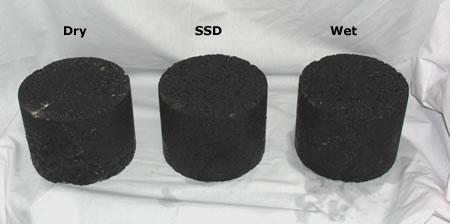Overview
The bulk specific gravity test is used to determine the specific gravity of a compacted HMA sample by determining the ratio of its weight to the weight of an equal volume of water.
The bulk specific gravity test measures a HMA sample’s weight under three different conditions (Figure 1):
- Dry (no water in sample).
- Saturated surface dry (SSD, water fills the HMA air voids).
- Submerged in water (underwater).
Using these three weights and their relationships, a sample’s apparent specific gravity, bulk specific gravity and bulk SSD specific gravity as well as absorption can be calculated.
HMA bulk specific gravity is needed to determine weight-volume relationships and to calculate various volume-related quantities such as air voids and voids in mineral aggregate (VMA).
The standard bulk specific gravity test is:
- AASHTO T 166: Bulk Specific Gravity of Compacted Bituminous Mixtures Using Saturated Surface-Dry Specimens
- ASTM D 2726: Bulk Specific Gravity and Density of Non-Absorptive Compacted Bituminous Mixtures
Background
Specific gravity is a measure of a material’s density (mass per unit volume) as compared to the density of water at 73.4°F (23°C). Therefore, by definition, water at 73.4°F (23°C) has a specific gravity of 1.
Bulk Specific Gravity Use
Superpave mix design is a volumetric process; key properties are expressed in terms of volume. However, direct volume measurements are difficult, therefore weight measurements are usually made and then converted to a volume based on material specific gravities. Bulk specific gravity is involved in most key mix design calculations including air voids, VMA and, indirectly, VFA. Correct and accurate bulk specific gravity determinations are vital to proper mix design. An incorrect bulk specific gravity value will result in incorrectly calculated air voids, VMA, VFA and ultimately result in an incorrect mix design.
Methods of Determining Bulk Specific Gravity
Although the Test Description section describes the standard AASHTO T 166 saturated surface dry (SSD) water displacement method, there are a number of other methods available. Each one uses a slightly different way to determine specimen volume and may result in different bulk specific gravity values.
Water Displacement Methods
These methods, based on Archimedes Principle, calculate specimen volume by weighing the specimen (1) in a water bath and (2) out of the water bath. The difference in weights can then be used to calculate the weight of water displaced, which can be converted to a volume using the specific gravity of water.
Saturated Surface Dry (SSD)
The most common method (and the one described in the Test Description section), calculates the specimen volume by subtracting the mass of the specimen in water (Figure 2) from the mass of a SSD specimen. SSD is defined as the specimen condition when the internal air voids are filled with water and the surface (including air voids connected to the surface) is dry. This SSD condition allows for internal air voids to be counted as part of the specimen volume and is achieved by soaking the specimen in a water bath for 4 minutes then removing it and quickly blotting it dry with a damp towel.
Wednesday, 25 January 2012
//
Labels:
Engineering
//
0
comments
//
0 comments to "Bulk Specific Gravity of pavement cube"
vfg
Search
About This Blog
Popular Posts
-
The Fuji Instax Mini 25 and Instax Mini 7S are a couple of moment picture zoom lens utilizing Fuji's Visa measured moment picture. In th...
-
When I pulled the Fujifilm Instax 200 out of my picture clicker pack at a familiar Sunday outing to a neighborhood small time baseball amuse...
-
The above picture is one of the most famous picture in the world. If you are the requester band Rage Against The Machine, the picture above...
-
The hotel room sports a modern yet cozy design and everything you need is provided for. The bed is super comfortable and remains the thing I...
-
Radisson - Blu Hotel , Berlin Germany is the world's largest cylindrical aquarium , named Aquadom . It is 25 meters ...
Feedjit













Post a Comment